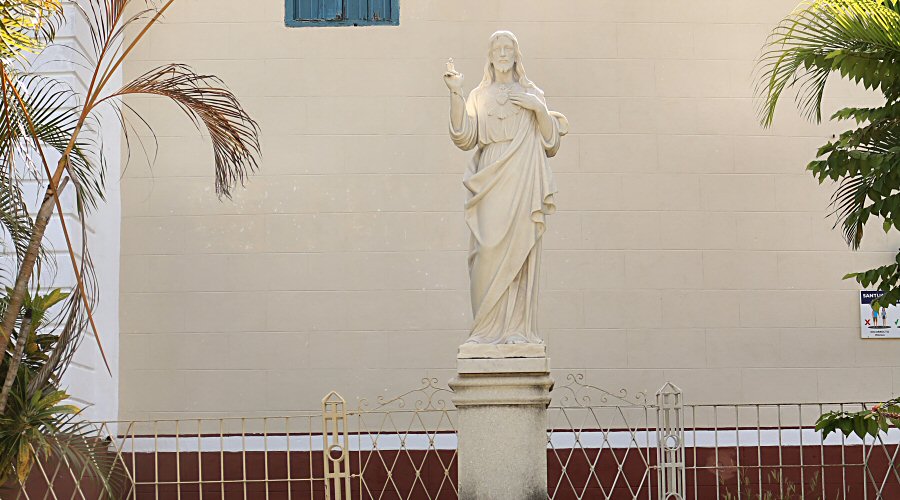
ARCHITECTURAL FEATURES
The humble church is built on a hill,
overlooking the sea like the Santuario de Nuestra Señora de
Regla in Chipiona.
The first building was constructed with planks and thatched
roofs. After the storm San Rafael destroyed the simple
construction, the hermitage was built of adobe and tiles.
Since that day the Virgin has been over the main altar, from
where she was protecting the Havana Bay.
The building is surrounded by an iron fence with
spear-shaped bars extending between square stone columns.
Entry is through a portico located on the neoclassical front
façade, designed in accordance with the taste of Abbot
Espada y Landa. The entrance is crowned by a spacious
semicircular arcade culminating in a gable. The simple but
beautiful front façade features blue-painted wooden windows
guarded by fixed bars on either side of the entrance.
Another door, designated for daily use, is located on the
side of the building.
Above the entrance door and above the ceiling of the central
nave rises the bell tower, a square structure consisting of
the roof and four columns. By using the columns instead of
walls, the bell tower structure gained enormous openings
topped by semicircular arches.
The interior of the church is dominated by blue and white
colors. Blue symbolizes the sea, while white symbolizes warm
hospitality enriched by immaculate purity.
Another chapel of the Virgin of Regla is located about ten meters outside
the church. It was built at the beginning of this century by
a devotee who had been a chambermaid at the church, Mrs.
Francisca Cárdenas.
The church's altars are not covered in precious metals, as
it was usual in Latin American countries. The main altar has been in
the church since 1693, after it was rebuilt following the
hurricane. Over the altar there is the black Virgin of Regla,
venerated by Catholics, carrying a white child (Jesus
Christ) on her arm.
Even the Virgin is not ostentatious. Her face is barely
visible against her blue robe adorned with white lace. The
sea-blue of her dress symbolizes the Bay of Havana, which
the Virgin of Regla is protecting. According to Santería belief,
she is associated with the orisha Yemayá, the orisha of the
sea and patron saint of sailors.
Santería belief says that it was the slave Eulogio
Gutiérrez who arrived in Regla to implement the Regla Ifá
(the rules of Santería), a mission assigned to him by Olofi
and Orula from faraway Africa.
Olofi is the name given to one of the three manifestations
of the Supreme God in the Yoruba pantheon. Olofi is the
ruler of the Earth. The Supreme God has three
manifestations: Eledumare, the Creator; Olorun, ruler of the
heavens; and Olofi, who is the conduit between Orún (Heaven)
and Ayé (Earth). Orula is the Orisha of divination and
wisdom within the Yoruba religion. He is the supreme oracle
and master spiritualist who sees all and knows all.
This sect flourished in Regla from the late 19th century, so
the first santeros emerged from the small town. According to
Santería, the Virgin of Regla is named Yemayá. Yemayá, being
one of the orishas, is the goddess of the sea. She
represents fertility and is the protector of children. Her
symbol is the number 7, representing the seven seas. For the
indigenous people brought to the Americas as slaves, she is
believed to carry the natural power and energy of Africa.
These beliefs which originated in the western part of
Southern Nigeria in Africa, consider Yemayá as the orisha who
loved hunting and wielding the machete. They recognize her
as cunning, wrathful, and indomitable, but also capable of
imparting just punishments.
On every September 8th, thousands of pilgrims flock to this
church in Regla to celebrate the saint's day. The statue is
taken out from the church and carried for a procession
through the streets. At these celebrations, everyone,
regardless of its social status, took to the streets to pay
tribute to the saint of their devotion. Each
person modeled their fervor according to their own religious
beliefs. While whites prayed to Our Lady of Regla, blacks
and mulattoes venerated Yemayá, accompanied by drumbeats and
some liquor extracted from the juice of sugarcane stalks.
Thus, Regla is one of the places where you can best
understand the syncretic relationship between Catholic
beliefs and the African traditions throughout Cuba.
